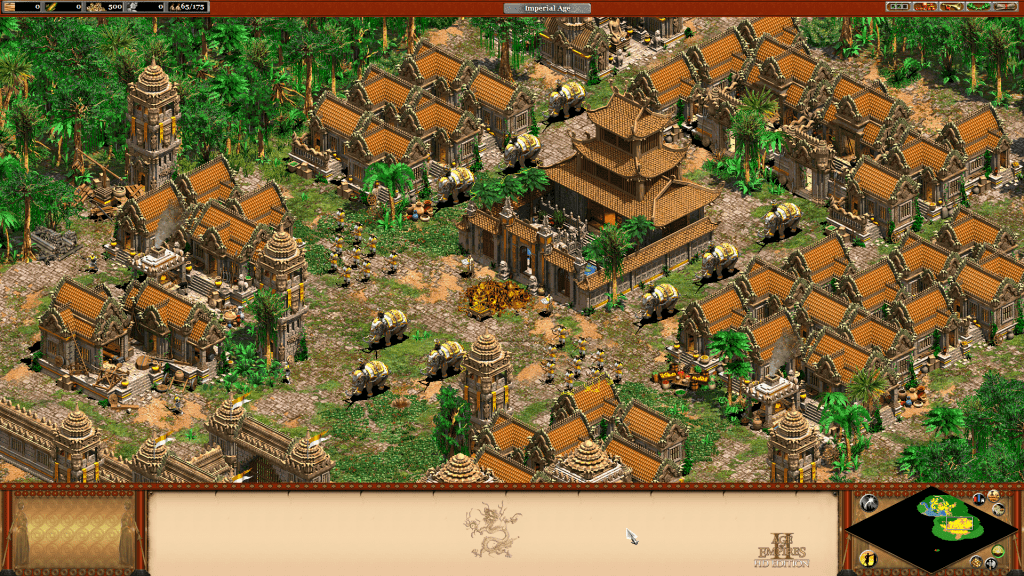
Command the rebellion against the Chinese Ming Empire and become a hero to the Vietnamese. Lead your people to independence through waging guerilla warfare with an extremely powerful arsenal of ranged units. The Vietnamese unique unit is the Rattan Archer, a heavily-armored ranged unit that is effectively impervious to enemy archer attacks.
► Vietnamese.mp3
Quick Card
Archer civilization
- Reveal enemy positions at game start
- Archery Range units +10% HP Feudal, +15% Castle, +20% Imperial Age
- Free Conscription
Unique Unit:
- Rattan Archer (archer)
Unique Technologies:
- Chatras: Battle Elephants +30 HP
- Paper Money: Tributes 500 gold to each Ally
Team Bonus:
- Have access to Imperial Skirmisher upgrade
History
According to a fifteenth-century legend, the first Vietnamese state was founded in 2879 BC when king Hung Vuong united the tribes of the fertile Red River delta in Northern Vietnam. Thanks to the natural boundaries of mountains in the north and sea to the south, successive states were able to defend their independence for several centuries. In the first century BC, however, the Han dynasty of China invaded the Red River delta in order to secure their trade interests. For over a millennium, the Vietnamese would live under Chinese rule.
Even though Chinese rulers persistently tried to force their culture and traditions on the region, their efforts were only partially successful. The Vietnamese people retained a sense of pre-Chinese identity, which resulted in several rebellions against the central government. When the Chinese Tang dynasty collapsed in the early tenth century AD, local leaders used the opportunity to gradually reclaim independence. In 938, general Ngô Quyền repelled the last Chinese invasion and proclaimed himself king of the Vietnamese kingdom, known as Dai Viet. For the next centuries, successive Vietnamese dynasties would not only resist new Chinese invasions, but also expand the empire southward against the Cham. Three powerful dynasties were especially important during the Middle Ages:
In 1009 Lý Công Uẩn, a former temple orphan and commander of the palace guard, founded the Ly dynasty when he was elected as the new emperor. The Ly dynasty (1009-1225) laid the foundations for a powerful Dai Viet through the development of an organized central administration. Adopting the Chinese model to their own needs, the Ly emperors established the Imperial Academy where all nobles and bureaucrats were educated in Confucianism. Officials were recruited based on their scores in an examination. In addition, the Ly dynasty promoted Buddhism as the state religion and enhanced the irrigation network.
The Ly emperors were succeeded by the Tran dynasty (1225-1400). In this period, the Vietnamese culture witnessed a golden age: theatre and literature in the Vietnamese language developed. Many innovations, such as paper money and new medicines, were introduced. Nevertheless, the Tran are most famous for their military skills. In 1257, 1284, and 1287 they successfully repelled the Mongol armies of Kublai Khan through clever use of terrain and guerrilla tactics. In the fourteenth century, spurred by economic and demographic expansion, the Vietnamese campaigned against the Champa kingdom to enlarge their empire, but ultimately failed to conquer the whole kingdom. The Tran upheld a specialized army of infantry and archers, but reduced its cost by rotating troops in training during peacetime. By 1390, the Vietnamese had also adopted the use of gunpowder from China.
After the Ho dynasty (1400-1407) had overthrown the Tran emperors, Ming China launched an invasion under the guise of restoring the Tran dynasty. Two decades of harsh rule followed until Lê Lợi, son of a local village leader, started a rebellion in 1418. After ten years, Lê Lợi restored the independence of Dai Viet by defeating the Ming rulers. During the Le dynasty (1428-1788), the state converted to Confucianism as the main religion and the law system was remodeled according to Chinese fashion. Under the emperor Le Thanh Tong (1460-1497), Dai Viet witnessed another golden age: he restored agricultural production, revised the tax system, and reorganized administration. In 1471, the emperor succeeded where the Tran did not: he defeated the Champa Kindgom. After Le Thanh Tong, the Le dynasty held the throne through much of the pre-modern period and became the longest ruling dynasty in Vietnamese history.

